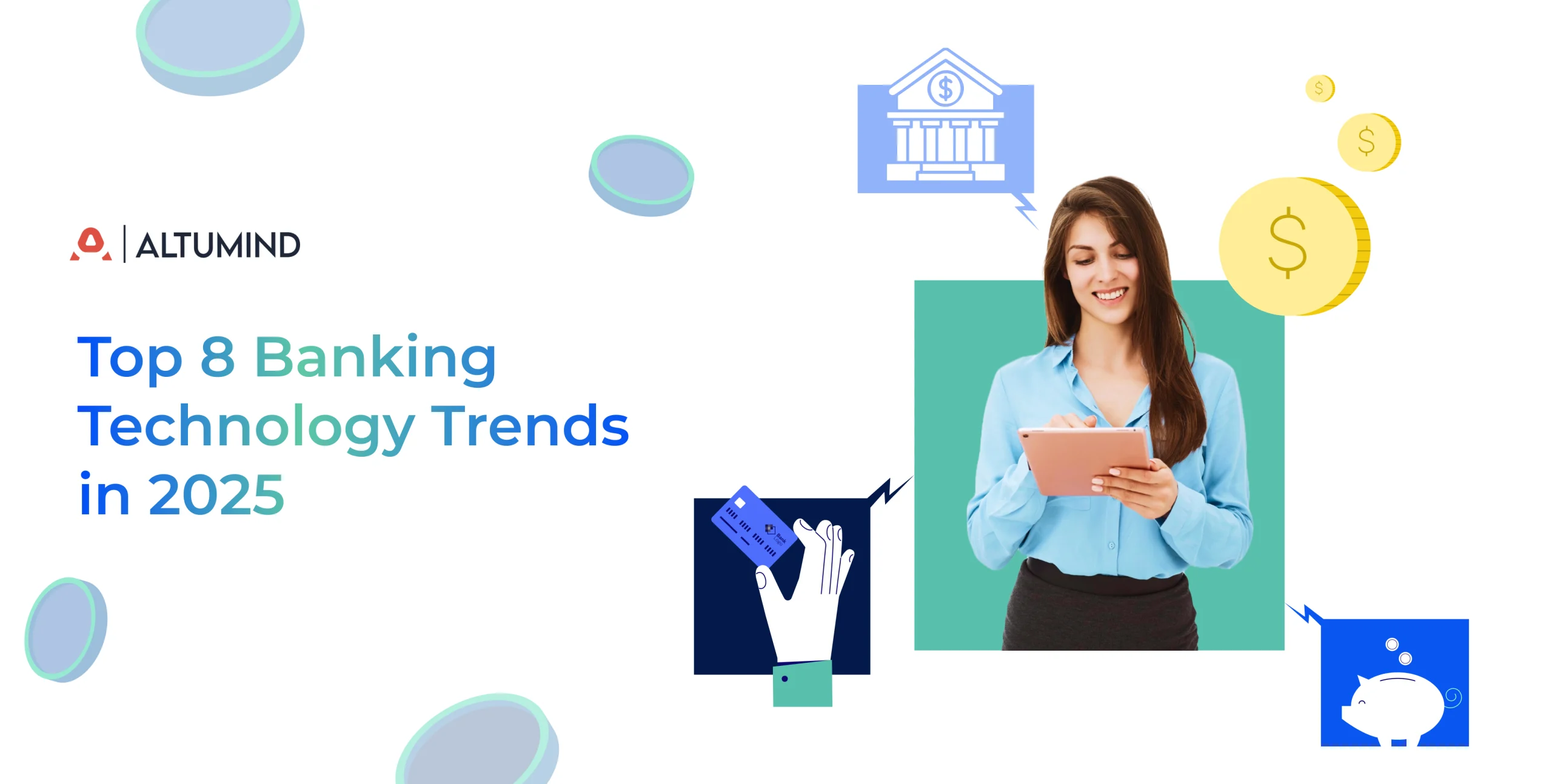As we move into 2025, the banking industry is leading a technological revival, adopting bleeding-edge digital banking trends that aim to transform the core nature of the financial ecosystem. Banks hope to reshape the conventional legacy systems for increased efficiency, security, and customer satisfaction. A lot of it is already underway and 2025 will expedite this momentum.
Technology and finance merging is no longer a distant forecast, rather it is a reality unfolding before us. In 2025, banks aren’t just upgrading systems, they are rethinking what is possible across operations, compliance, and customer experience. Enhanced protections, better safeguards around financial data, streamlined processes, and lower operational costs while maintaining omnichannel access will make the banking system more trustworthy. Let’s explore some new banking technology innovations coming up in 2025.
Top 8 Digital Banking Trends
1. Generative AI:
Gen AI fraud-detecting algorithms prevent scams by analyzing transactional data patterns and anomalies. It can also generate sophisticated credit scoring models by evaluating applicants’ creditworthiness from their transaction history and economic indicators. Further, chatbots powered by Gen AI and Natural Language Processing (NLP) make customer inquiries more personable 24/7 and reduce call center costs. Here are some other use cases of this banking technology:
- Extract, summarize, infer, and auto-populate information from news and documents
- Predict market trends and outcomes from historical data and present market conditions
- Provide tailor-made investment advice to investors seeking wealth management
- AI and RPA can automate repetitive tasks and improve operational efficiency
2. Cloud Computing:
Cloud-first banking is becoming the default. From improving uptime to reducing TCO, banks are embracing cloud-native infrastructures to scale faster and operate smarter. Altumind helps BFSI enterprises modernize with cloud and infrastructure management services that accelerate secure, compliant transformation and accelerate fintech innovation.
Banks are even leaning towards a hybrid model wherein they leverage tools such as Anthos or Azure Arc to handle sensitive data on-premises while using public clouds for scalability. Further, cloud-based productivity and collaboration tools such as Microsoft 365 and Teams increase efficiency, reduce infrastructure costs, and support hybrid work models.
Here are some other use cases of this banking technology:
- Better compliance with regulatory frameworks like PSD2 and AMLD5
- Unify customer data, predict customer behavior, and offer hyper-personalization
- Implement API ecosystems to facilitate third-party fintech integrations
- Low latency, reduced downtime, and high throughput for payment gateways and platforms
- Improved Cybersecurity via proactive threat detection and real-time threat mitigation
- Cloud-based disaster recovery (DRaaS) ensures faster recovery and increased resilience
3. Advanced Analytics:
Another leading banking technology trend for 2025 is advanced Analytics. Banks are leveraging predictive models to help gather deeper customer insights and reduce churn, besides using risk models to assess credit, market, and operational risk.
Data warehouses like Snowflake, tools like BigQuery, and BI platforms are enabling institutions to analyze processes, uncover inefficiencies, and optimize operations for faster, more reliable service delivery.
Here are a few high impact use cases of this banking technology:
- Enhance loan underwriting by evaluating more granular data points for better risk scoring
- Ensure regulatory compliance by mining transactional and operational datasets
- Strengthen onboarding verification through deeper customer data checks
- Personalize product offerings by analyzing customer sentiment and feedback
- Track market trends with granular analysis to drive smarter investment decision
Altumind partners with BFSI organizations to transform raw data into actionable intelligence—helping reduce churn, ensure compliance, and unlock smarter lending strategies.

Climbing the corporate hierarchy is an option that can be made available to all. If competent, resources can move vertically within the same department or diagonally from one function to another. These resources are already well-versed in your focus areas, culture, and practices and well-accustomed to the ecosystem.
4. Hyper-automation:
As part of the ongoing digital transformation, banks are shifting towards hyper-automation through AI, ML, RPA, etc. The goal is to automate routine work, facilitate data-driven decision-making faster, lower laborious activities, flag suspicious transactions in real-time, and improve customer response time. Further, banks hope to create a more personalized and seamless customer experience.
From automating KYC to streamlining loan approvals, hyper automation enables banks to operate at digital speed. Altumind enables banks to reengineer workflows using RPA, AI, and ML to meet customer demands faster and at scale.
5. Use of APIs (Open banking):
Another concept in the list of digital banking trends for 2025 is API – Application Programming Interface – which has become a strategic asset for banks to connect disparate systems. APIs allow banks to connect legacy software with new-age technology, fintech apps, and other banks, facilitating interoperability and a secure, flexible, and efficient data exchange between multiple systems – leading to it becoming a reliable banking technology. Here are some other advantages of APIs:
- Integrate new functionalities and services without renovating existing systems
- Integrate customer data across multiple platforms for a unified view
- Integrate with payment gateways and processors for quick and secure payments
- Developers can easily build services for 3rd-party apps and reach more customers
- Accelerate loan approvals – integrate with credit bureaus and other financial services
- Use microservice architecture to develop APIs for specific banking functions
6. Immersive Technologies:
Wearable tech, centered on Augmented reality (AR), virtual reality (VR), and mixed reality (MR) may create more engaging, immersive, and interactive customer experiences in 2025 – reinforcing the new age omnichannel banking trends taking shape globally. With the advent of 5G, ongoing improvement in digital penetration, and headsets becoming more affordable and accessible – wider adoption is expected. Further, these technologies can be used to create convenient experiences for employees. Here’s what else you stand to gain:
- Customers visit virtual branches, instead of coming to an offline branch
- Interactive visuals improve understanding and engagement of products
- Makes it easier and more convenient to assist customers
- Peers can facilitate remote meetings and collaborations from anywhere
- Build interactive financial literacy programs and workshops
7. Blockchain:
Blockchain, another promising digital banking innovation, ensures better security and transparency leading to modernization gains for the banking industry. Banks will be able to realize real-time settlement of transactions, streamline global payments, and reduce fraud through Decentralized Ledger Technology (DLT). The immutable nature of the blockchain leads to data integrity and transaction trail transparency, increasing stakeholder trust. Here are some more benefits of the same:
- Distributed Ledger for real-time settlement reduces the need for intermediaries
- Lower operational costs and minimize human-induced errors
- Blockchain’s cryptographic features diminish fraud risks and protect sensitive data
- Smart Contracts let you enforce and automate contract terms
- Asset tokenization allows fractional ownership of assets
- The immutable ledger allows transparent and tamper-proof audit trails
- Verifiable digital identities, enhances authentication and decreases identity theft risks
8. Neobanking:
Neobanking is a trend in line with impactful global digital banking innovations, where online-only banks will grow by leaps and bounds in 2025. The capex on infrastructure, per-head wages, and running & maintenance costs of traditional banks have made them shift to online banking, lowering the footfall to the offline channels and stakeholders shifting the entire ecosystem to online mode – giving birth to Neobanking. They provide almost all the services online, so much so that even KYC gets done online. Here’s more:
- Mobile apps and websites facilitate 24/7 access to all the features
- More cost-effective to the banks and they pass on these benefits to the consumers
- The account onboarding process is more seamless and faster
- Equipped with easy-to-use visual budgeting and financial planning tools
- Syncs easily with other financial apps and services
- Easier to give tailored advice – everything goes down on one app, no reliance on clerks
Embrace the Next Wave of Digital Banking Trends
In 2025, the banking industry can’t afford to ignore the new banking technology innovations– they’ll have to give in, capture the bank technology trends, and overhaul their financial ecosystem to serve customers better, increase efficiency, heighten security, and increase their bottom line. It may seem daunting at first, but the sooner they embrace these digital banking trends the sooner they hit their optimum potential. A tech-driven world awaits the banking sector provided they act now.
If your banking operations feel gridlocked by legacy systems and sluggish workflows, it is time for a rethink. Altumind brings BFSI-specific digital transformation expertise, enabling banks to embrace disruption, modernize at scale, and deliver consistent customer value. We have been at the forefront of capturing measurable and value-driven omnichannel banking trends and consistently delivering tailor-made, impactful, and affordable solutions for marquee clients worldwide.


